
An early aerial photo of Happy Valley, a construction camp that was like a small city and used to help build the former K-25 site in west Oak Ridge. This picture was taken May, 22, 1944, by Ed Westcott, the official government photographer in Oak Ridge during World War II. (Photo courtesy Ed Westcott/Emily Hunnicutt)
It was once home to a large construction camp that was like a small city and housed workers building K-25 during World War II.
Now the 160-acre parcel known as Happy Valley has been sold.
Happy Valley was in west Oak Ridge, across State Route 58 from the K-25 site. One of three major sites in Oak Ridge, K-25 was built to enrich uranium for atomic weapons as part of the top-secret Manhattan Project during World War II.
Today, Happy Valley appears to be mostly a rolling tree-covered landscape between Oak Ridge and Kingston along SR 58. To the public, there is little or no obvious evidence of what was once there—homes, a grocery store, schools, a post office, recreation halls, a gas station, and a bowling alley.
But those who have walked the property have seen evidence of the small city that was once there.
Former Oak Ridge Mayor David Bradshaw walked the property in an episode of “Secret Cities of the A-Bomb” that was part of the “Lost Worlds” series by Atlantic Productions for the History Channel in 2006.
Even then, Bradshaw said Wednesday, you could see roughly where roads had been between houses, and old foundations—slabs in the ground—were visible. You could see where lavatories and sinks would have drained in community bathhouses, and fire hydrants were visible, Bradshaw said.
“There were no buildings, but there was clear evidence of what had been there,” Bradshaw said. “It was more or less to support the building of K-25.”
Happy Valley had 15,000 people living there at one time, and it wasn’t just shacks, Bradshaw said. It was like a little city with the things that a city would need. In terms of population, it was about half as large as Oak Ridge is today.
K-25 was a ways from the city that is now Oak Ridge, and Happy Valley was built so K-25 workers could be closer to the work site, Bradshaw said.
While under construction, more than 25,000 personnel worked on K-25, which was built in only 18 months between 1943 and 1945. (Besides the workers at Happy Valley, Steve Goodpasture, artifact curator at the K-25 History Center, said there were more workers, about 2,000 of them, living in hutments and houses in the Wheat community.)
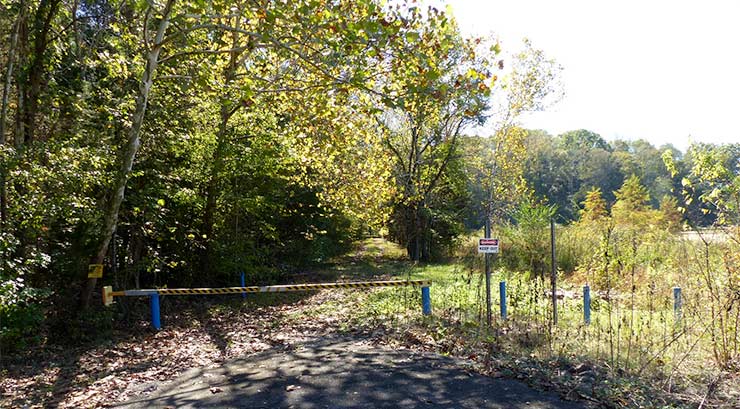
Part of the Happy Valley property in west Oak Ridge is pictured above on Thursday, Oct. 19, 2017. (Photo by John Huotari/Oak Ridge Today)
Ray Smith, Oak Ridge city historian and Y-12 National Security Complex historian, helped with the “Lost Cities of the A-Bomb” episode, and he said people were probably leaving Happy Valley by the end of World War II. Some of the workers might have stayed in Oak Ridge, but most probably moved on to other construction sites, Smith said.
Most of the homes in Happy Valley were hutments, which were small, square residences that measured 16 feet by 16 feet.
But Goodpasture said there were also trailers, barracks, and dormitories.
Roane County Executive Ron Woody said he’s walked most of the Happy Valley property.
“It’s just amazing to see the fire plugs, watering stations, and foundations of buildings,” Woody said Thursday.
He estimated one building had a “footprint” of between 4,000 and 5,000 square feet.
Happy Valley was purchased from the U.S. General Services Administration, or GSA, by an Oak Ridge company called Bionomics for $391,000, according to a deed dated November 2, 2016, and filed with the Roane County Register of Deeds. Bionomics is located on Bear Creek Road in west Oak Ridge, south of K-25 and west of the Y-12 National Security Complex.
On Friday, Bionomics Vice President John McCormick said there are no immediate plans for the property. The 160 acres starts just past the Visitor’s Overlook at the East Tennessee Technology Park, the former K-25 site, and extends up to the U.S. Department of Energy Haul Road a short drive toward Oak Ridge. The Happy Valley property is up to about 200 to 300 yards deep in spots, McCormick said.
He thinks about 80 acres can be developed in eight flat 10-acre plots. There are already utilities there—electric lines and water run through the property—and sewer lines are available across SR 58, McCormick said.
Right now, Bionomics is keeping open the ETTP Visitor’s Overlook, which is part of the Happy Valley land, and keeping K-25 information in there. They could also add materials for the Roane County Visitors Bureau, McCormick said. The overlook has been remodeled and painted, and Bionomics is trying to keep it clean and lit.
Wade Creswell of The Roane Alliance said there has been an agreement under which The Roane Alliance will cover utilities at the ETTP Visitor’s Overlook, the City of Oak Ridge will open and close it, and the Roane County Sheriff’s Department will mow it.
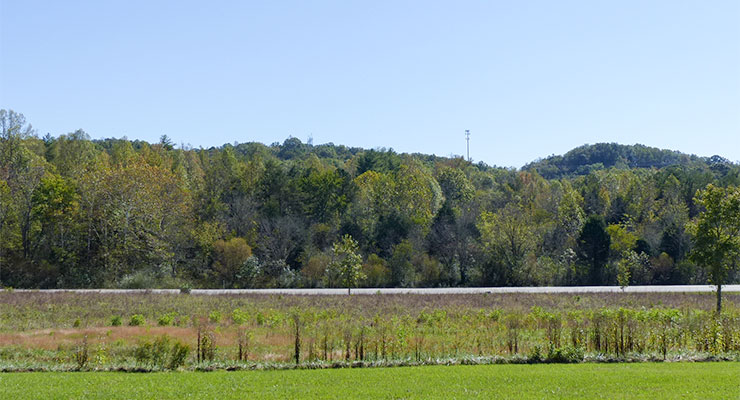
Happy Valley is pictured from East Tennessee Technology Park, the former K-25 site, on the other side of State Route 58 in west Oak Ridge on Thursday, Oct. 19, 2017. (Photo by John Huotari/Oak Ridge Today)
The GSA sold the Happy Valley property through a public auction that started online on July 7, 2016, and ended September 10, 2016. The bidding opened at $275,000 with a $10,00 deposit.
There were three registered bidders, but only two actually placed a bid. Two bidders were from East Tennessee, and one was from North Carolina.
McCormick said the property, previously owned by the U.S. Department of Energy, never had radioactive contaminants on it. He’d prefer more of a “clean use” of the land and would be hesitant to sell it for something like a waste treatment facility.
Possible uses could include mixed-use sites such as office/light industrial, business parks, a hotel, and a visitor’s center.
“We want to bring some jobs to Roane County,” McCormick said.
The land behind the Visitor’s Overlook is pristine and could possibly be used for something like a dog park, McCormick said.
Bionomics is involved in the disposal of very low-level radioactive waste. The company works with universities, hospitals, and research facilities, and companies that include Energy Solutions and Perma-Fix. Bionomics, which has been in Roane County 27 years and at the Bear Creek location for 10, does not plan to move onto the Happy Valley property, McCormick said.
“My main thought is to keep it more a business/light industrial type park,” McCormick said.
The Happy Valley land is also known as Parcel ED-3 and Parcel ED-3 Western Expansion Area. It had been declared surplus by the U.S. government, and DOE no longer needed it. The GSA is the agency that disposes of federal property.
No structures were on the property when it was declared excess. DOE had demolished all property improvements in the early 1950s.
Officials had reportedly checked to see if any other entities, such as the city or county, would want the land.
A pond that is just south of K-25 and on the south side of SR 58, on the same side of the road as the Happy Valley property, remains under the oversight of DOE’s environmental management program.
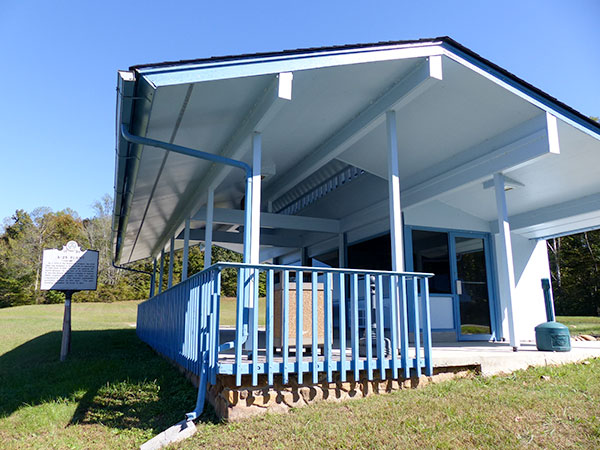
The Visitor’s Overlook, part of the Happy Valley property purchased in November, is pictured above across from East Tennessee Technology Park, the former K-25 site, on Thursday, Oct. 19, 2017. (Photo by John Huotari/Oak Ridge Today)
Happy Valley is across from the planned airport at ETTP, and it’s not clear how that development might affect the possible future development or value of the Happy Valley property. McCormick said the airport could help the value of the Happy Valley property, but it depends upon what comes to the airport.
The GSA notice said Happy Valley was once a campground of trailer homes and hutments for the thousands of construction workers building the K-25 complex during World War II.
“Happy Valley was a self-contained facility that included schools, cafeterias, bakery, post office, warehouse, theater, recreation halls, and a bowling alley,” the GSA said. “A commercial center featured a grocery store, barber shop, shoe shop, and dry goods store. All improvements were demolished in the 1950s.”
The property is wooded, a rolling terrain of mixed pine and hardwood trees, the GSA said. The one developed area is the ETTP Visitor’s Overlook, which has a small paved parking lot and an enclosed pavilion.
The property has 3,800 feet of highway frontage on SR 58, and it’s a short drive from Interstate 40 and I-75.
The GSA said that moving underused properties like Happy Valley out of the federal inventory “allows for local use that better promotes economic growth and saves taxpayer dollars.”
There are known wetland sites on the property and an unnamed stream that runs along the south side of a section of State Route 58, according to the property deed. The deed prohibits residential housing, an elementary or secondary school, or any child care facility or children’s playground.
The deed outlines a long list of permitted uses, including light to heavy manufacturing, public utility facilities, warehousing and distribution facilities, offices, material and waste treatment facilities, commercial and public recreation uses, and research and testing facilities, among other possible uses.
More information will be added as it becomes available
See the parcel detail here.
See the GSA auction notice from 2016 here.
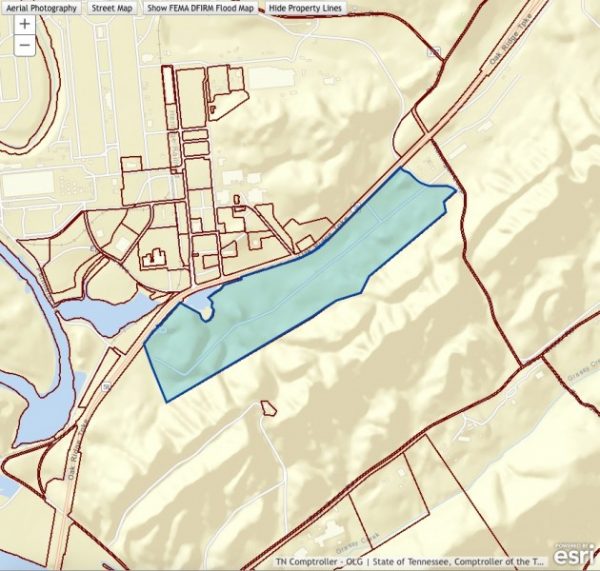
The Happy Valley property is pictured above in this map available on the state’s Tennessee Property Viewer website. East Tennessee Technology Park, the former K-25 site, is just north of the land. The ETTP Visitor’s Overlook turnoff is visible on the left end of the parcel and the U.S. Department of Energy haul road is visible on the right side.
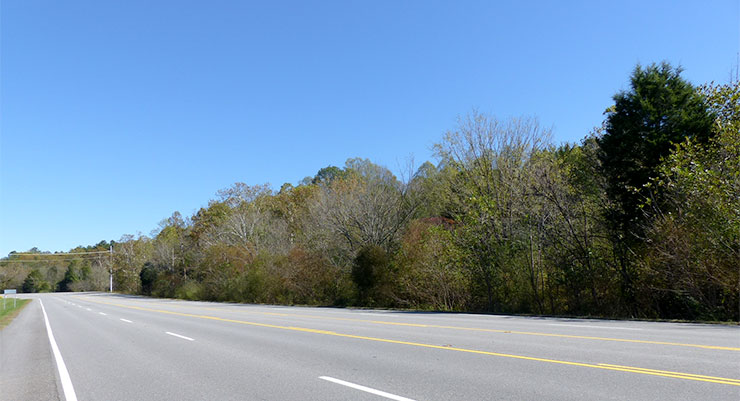
Part of the Happy Valley property is pictured along State Route 58 in west Oak Ridge above on Thursday, Oct. 19, 2017. (Photo by John Huotari/Oak Ridge Today)

The Visitor’s Overlook, part of the Happy Valley property purchased in November, is pictured above across from East Tennessee Technology Park, the former K-25 site, on Thursday, Oct. 19, 2017. (Photo by John Huotari/Oak Ridge Today)
Do you appreciate this story or our work in general? If so, please consider a monthly subscription to Oak Ridge Today. See our Subscribe page here. Thank you for reading Oak Ridge Today.
Copyright 2017 Oak Ridge Today. All rights reserved. This material may not be published, broadcast, rewritten, or redistributed.
njengland says
I’ve always known that pond across from K25 as “the Duck Pond.” Anyone else called it Duck Pond?
johnhuotari says
I’m not sure. I’m trying to remember if I’ve seen many ducks at that pond recently.